What kind of 15-year-old could wrangle Bernie Wrightson, Michael Kaluta, Reed Crandall, Howard Chaykin, Larry Todd, Kenneth Smith, Frank Brunner, and others to contribute to his fanzine? Robert Gerson, that’s who! This month, the fabulous, the entertaining, Reality 2!
Reality 2: 1971
Publisher/Editor: Robert Gerstenhaber (Robert Gerson)

Let us celebrate the joys of being a 14-year-old New York comics fan and aspiring artist in the 1970s. If you had the huevos to ask your favorite artists for sketches at the local cons, and the drive to publish, you could have been Robert Gerson…or Adam Malin! Gerson published this month’s subject, Reality 2, but it was a healthy competition with his school mate since kindergarten and next door neighbor, Adam Malin (of Infinity fame, see issue five profiled here), that helped spark those self publishing fires. It didn’t hurt that one of their favorite magazines, Web of Horror, was closing its doors, with unpublished work still sitting around for young hucksters to eagerly snatch up. One of these stories begging for a place to be seen was Len Wein and Michael Kaluta’s Death is the Sailor, of which you see two pages from below.

Though Kaluta would obviously go on to do incredible work as he gained in skill and experience, this story is done by a young artist who was no slouch, even way back then. Kaluta renders the giant Kraken squid with squishy abandonment. The artist also appears to have done his research, judging by the details in the great wooden ship that follows the giant sea-bound beast. Like many stories following in the grand EC tradition, there is a twist ending that you will have to download the pdf to see! Kaluta also did a two-page story specifically for the fanzine (As Night Falls), and has three one-page stories in the fanzine as well.
In a very nice TwoMorrows Alter Ego magazine article by the self avowed black and white publication fan Richard Arndt, Gerson cites the fanzines of the time as giving him the idea and initiative to publish his own fanzine. Some names you might recognize include Graphic Story Magazine, Witzend, Spa-Fon, Squa Tront, and Fantastic Fanzine, among others…several already profiled right here in Ink Stains.
From the aforementioned article in Alter Ego, Gerson talks about his relationship with Infinity editor Malin:
There was also a friendly “New York neighborhood” aspect of getting Reality up and running, thanks to my across-the-street rivalry with my school pal Adam Malin. We were in school together since kindergarten, read the same comics, copied and did our first drawings from the same Kirby and Steranko pages together. Adam was planning to publish Infinity magazine, and we had a fun rivalry going back then about who could get the most interesting art and interviews for their magazines. Adam is still a very close friend today, and we have a blast going back in the time machine to the days when we published our magazines.
Reality, like most creative endeavors, was the result of a specific time and place. There were several independent magazines published in the late 1960s that inspired me to create Reality. I recall studying several of the current issues of those magazines as I thought about what Reality’s contents would be. I was very impressed with Alter Ego #10, where Roy Thomas had a perfect balance between informative articles and interviews, with rare behind-the-scenes art along with just the right amount of humor. Then there was Jerry Weist’s great EC-devoted magazine Squa Tront, particularly #3 and 4, where Jerry was creating probably the most exciting graphic design work of all the independent magazines published during that era. His magazines were more creatively designed than most of what was appearing on the newsstands at the time. Then there was Wally Wood’s Witzend. Wood, and later Bill Pearson, really created one of the great illustrator-and-comic-artist magazines. What I really liked about Witzend was the blending in each issue of works by artists who had started out in the 1940s and 1950s, such as Reed Crandall, Frank Frazetta, Wally Wood, and Harvey Kurtzman, with the next generation from the 1960s, including artists like Art Spiegelman and Vaughn Bode. Witzend really did set the table for the next wave of creativity in comics and graphic stories.

Gerson scored several times over with what would become known as The Studio group of artists (Kaluta, Jeff Jones, Barry Smith, and Bernie Wrightson). Issue one of Reality would sport a Jones painting, while this issue had what is purported to be the first actual illustration of an early version of Bernie’s famous Swamp Thing character later done for DC comics (seen above). Gerson elaborates (from the same Alter Ego article):
At the time I didn’t even know I was publishing a Swamp Thing illustration. I was at Michael Kaluta’s apartment to pick up some of his artwork for the 2nd issue, and I mentioned that I really was hoping to have a piece by Bernie for the new issue, particularly since he hadn’t appeared in the first issue. So I’m asking Kaluta about how to get in touch with Wrightson—and at that moment Bernie walks in the door. Kaluta asks him if the drawing of Bernie’s that he has sitting next to his drafting table can be published in Reality. Mike grabs this beautiful drawing and shows it to me. Bernie says, “Sure, go ahead and print it.” It certainly was cool to publish an early Wrightson drawing.
A compatriot of Wrightson who appears in this issue of Reality, courtesy of the early demise of Web of Horror, is artist/writer Bruce Jones. Jones was kind enough to answer a few questions about this time of his life via email. Bruce actually got into fanzines in a sort of reverse of the usual sequence of events. He was already a pro, having a story in the first issue of Web of Horror called “Point of View.” “Outside-In” (two pages seen below) was scheduled, but the magazine folded before it could appear in print. So, this story is actually Jones’s first fanzine work! To Jones’s surprise, “a lot of people don’t realize this, but the fanzines paid money! It actually got some of us through to the next month’s rent. I think many fanzines formed by printing the early published and unpublished work of the EC artists like Frazetta, Krekel, Williamson and Foster—then when Jeff and Bernie and Mike and I came along (all strangely at the same time from disparate parts of the country) we were the next wave of that kind of illustrative style—because those guys were our heroes. Everybody else—people who worked for DC and Marvel—were either drawing like Jack Kirby or Neal Adams. Our group was more ‘jungle’ and ‘sci-fi’ oriented.” Though Gerson considered it a mark of integrity to pay his contributors, most zines only gave copies of whatever your work was printed in as payment.


When I asked Bruce whether he thought his fanzine work (or in his case, probably his Web of Horror work, combined with his fanzine work) helped him to get a foot in the door at the professional or larger companies, he replied,
As a writer yes, but as an artist my style and the style of my friends wasn’t conducive to superhero comics, with the possible exception of Wrightson, who did Swamp Thing [which, though mainstream, wouldn’t be considered a super-hero comic]. It was always tough getting work for Marvel and DC as an artist which is why I drew and wrote for the Warren type magazines, of which there were several then. Also we loved the way our stuff looked in black & white. Many of the fanzines actually had better reproduction than the four color comics. You could put one on your coffee table without being embarrassed in front of your girlfriend. Comic books weren’t “in” back then.
Jones continued on, talking about his fanzine days in general, by saying,
It was a fun time. We were all broke, but it was great hanging out, talking art, etc. Fandom was a much smaller and more personal entity. It’s now centered around superheroes, where as then it was more fantasy, sci-fi and illustration oriented—old school if you will. You talked more about the artists you loved and admired rather than which superhero was stronger or cooler. To give you an example, a [convention back then consisted of] a relatively small room with few people and comics everyone could afford as opposed to the current San Diego Comic convention, with hundreds of faceless people and fewer comics that no one can afford. I began to do less drawing and more writing, eventually turning to novels. My latest, THE DEADENDERS is available on Kindle and in trade paperback at Amazon. I did the cover art and the interior prose, so maybe I didn’t abandon illustration and narrative altogether!
In addition to the Web of Horror strips and other content we will get to soon, Jan Strnad contributed an article called “Fandom, Writing, and Catching Up.” This article takes issue with the practice of fanzines seeking out (and sometimes paying for) good quality art, but not paying as much attention to the quality of the writing. In addition to Strnad detailing the steps taken to produce a well written column or article, he takes issue with zine editors settling with an artist writing his own story, rather than contacting a writer to first write a story, and then have the artist adapt it, thus getting the best of both worlds. A good point made. Strnad cites such well written comics as Denny O’Neil’s Green Lantern and Green Arrow, Warren magazine’s publishing T. Casey Brennan’s award winning On The Wings of a Bird, and Hal Foster continuing to write Prince Valiant after leaving the illustration duties on that strip.
Following Strnad’s article is a portfolio featuring the incredible beautifully rendered work of Kenneth Smith, a favorite of editor Gerson. Consisting of five full pages of Smith’s faerie folk, strange beasties, and humorous eccentricities, an example of which can be seen below.

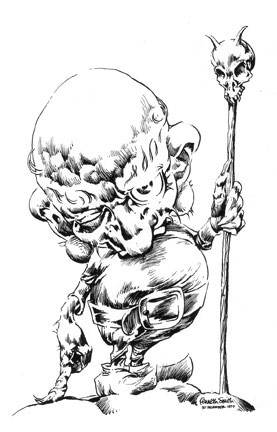 After being treated to Smith’s vivid imagination, we get an even bigger treat…the first published work of maverick Howard Chaykin. In a story written by Bill Stillwell, Renegade shows inklings of what would come later, for companies such as Atlas, First, Marvel, and many others. We have elements of many of Chaykin’s later work in a swashbuckling main character, a beautiful female companion, and fantastic spaceships. Of his dealings with Chaykin, Gerson wrote (again, from Arndt’s Alter Ego article),
After being treated to Smith’s vivid imagination, we get an even bigger treat…the first published work of maverick Howard Chaykin. In a story written by Bill Stillwell, Renegade shows inklings of what would come later, for companies such as Atlas, First, Marvel, and many others. We have elements of many of Chaykin’s later work in a swashbuckling main character, a beautiful female companion, and fantastic spaceships. Of his dealings with Chaykin, Gerson wrote (again, from Arndt’s Alter Ego article),
Chaykin was a Queens College classmate of my sister’s boyfriend, and one day they both appeared at our apartment while I was putting the first issue together. Howard was very persuasive in getting me to publish his work. Of course, Howard went on to create some very innovative work in comics, creating covers and pages that were more in touch with various illustration styles than most traditional comic art had been up to that point. Like acquiring so many of the Web of Horror stories, being the first to get Howard’s work into comics was another one of those odd little twists of fate that happened around the summer of 1970, when I was first putting the magazine together.
Below you see a page from the two page Chaykin/Stillwell story.


Following Renegade is a two pager by cover artist Larry Todd. The Amazing Liver, a “spaced-out humor and cosmic comedy,” echoes the wonderfully zany and sometimes subversive work Todd did for the underground comics of the late 60s and early 70s. You can see hints of the artist’s friend and contemporary, Vaughn Bode, as well as inspiration for fanzine artists of the 80s like the late David Heath, Jr. See a page below.

With additional art by Al Williamson, Reed Crandall, Frank Brunner (see the centerspread above), A. J. D’Agostino, and a gorgeous Kaluta back cover below (plus, as a bonus, see the related piece done for a digest magazine below that Kaluta graciously sent me via email), I am sure you will agree that Reality was at the forefront of the great art/story fanzines of the past. At some point, I hope to get someone to send me a copy or a pdf of the first issue, so we can see that as well. The reality is, Reality was fantastic!

Thanks this time go out to Richard Arndt for sending me links to many interviews he has done with people such as Richard Gerson, Adam Malin, and many others (see here); Robert Gerson himself, as well as Mike Kaluta and Roy Thomas. I would urge you to check out the whole line of TwoMorrows, which publishes Alter Ego, along with several other great publications, such as Back Issue and Draw. They are the best publishers of comic related material out there right now, in my opinion, along with Jon Cooke and Comic Book Creator. Check out Mike Kaluta’s site here, and see some incredibly beautiful Starstruck covers on the main page. Kenneth Smith’s can be found here.
As always, please download the pdf and leave comments! I would like to know someone out there is reading this darn column! Also, be here next month (December 1st), because I have a long out of print Steranko portfolio to show you…fifty pages worth!
Ken Meyer Jr.
kenmeyerjr@yahoo.com


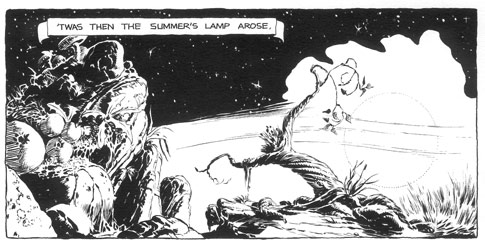
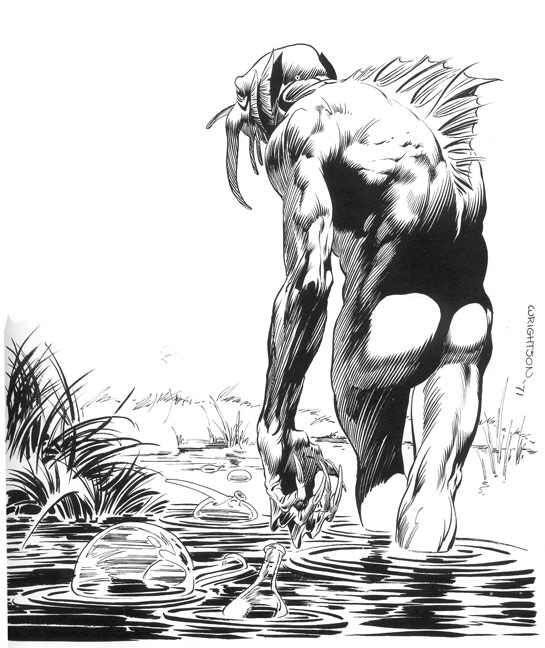

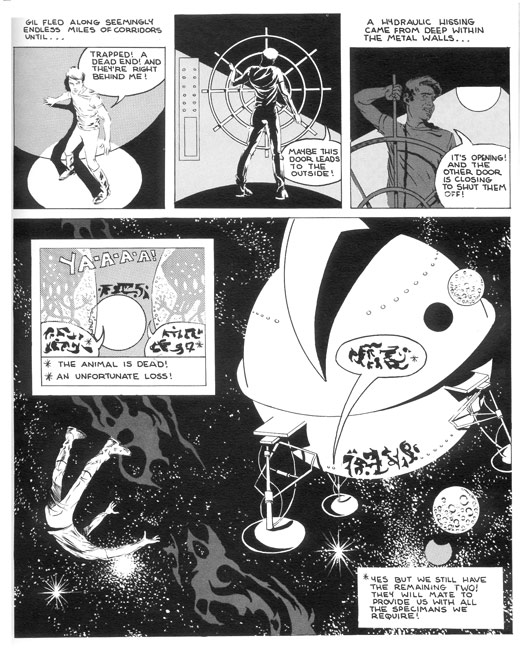

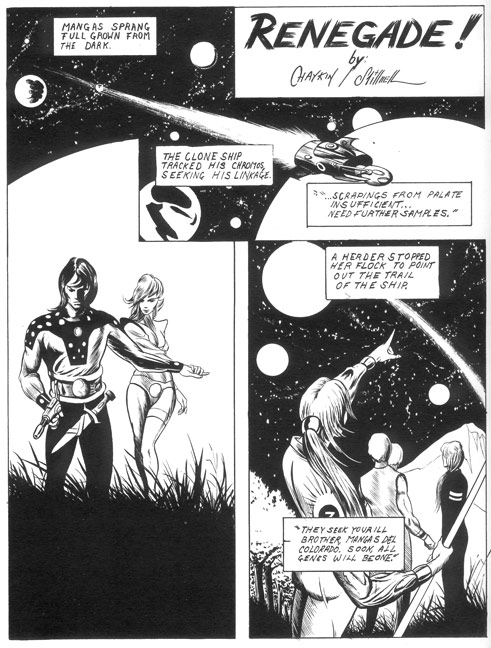


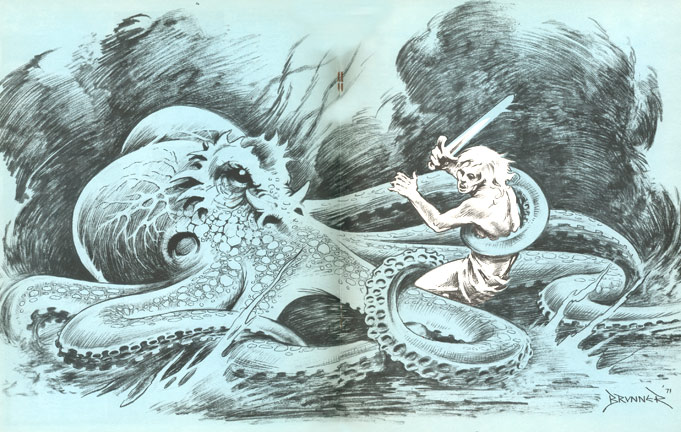
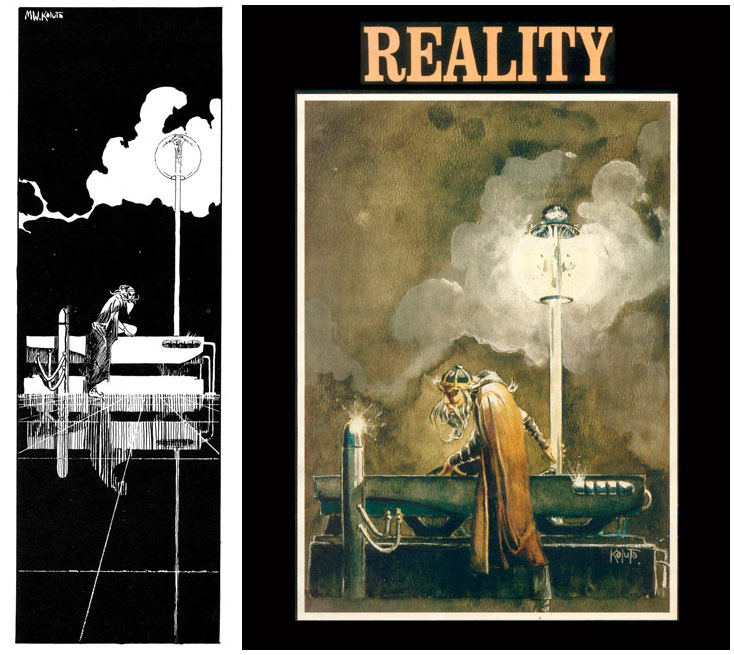
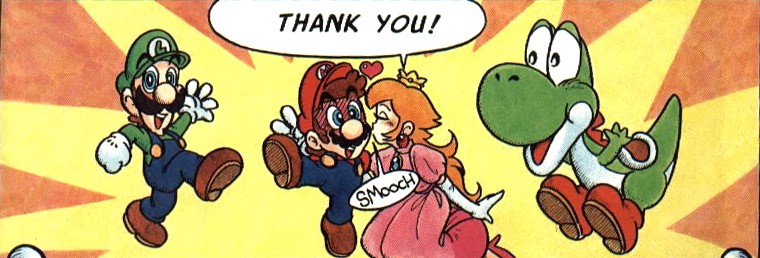
Great stuff!!!
Ken,
Somebody’s both reading and appreciating this column.
Great to see early Bruce Jones. His love of “pulp” themes has been evident throughout his career but I love “pulp”. Seeing this makes me miss his art. I’m glad to hear he’s still drawing but his clear storytelling and EC-based style was always compelling.
I noticed the ‘zine “Heritage” advertised in this ish. Ya got any of those lying around Ken?
Very cool look at this KM. I like Chaykin eventhough most people these days beat up on him. These illustrations from yester-year are a perfect example of his great work!
Really? Why would they beat up on him? He has had one helluva career, as far as I know! I am really curious. When a guy can create stuff like the various graphic novels and American Flagg, he is pretty far up there in my opinion.
Quick, say this five times fast…
Kaluta renders the giant Kraken squid with squishy abandonment.
Wow, Ken, some beautiful artwork here.
The Kaluta cover is gorgeous! The Wrightson piece is amazing too.
Heh…. “Kaluta renders the giant Kraken squid with squishy abandonment.”
Such a great line.
Ha! Thanks for recognizing my talent at purple prose! And a big thanks for leaving comments, people…it really makes a difference!
Another good one Ken! I haven’t been a fan of Chaykin’s work over the last several years and really think that a lot of his older stuff was a lot better. I do know that if I had a time machine I’d go back and pick up every fanzine I could get my hands on lol
Speech, I am not up on the current stuff, so I don’t know what Chaykin has been doing recently, to be honest. For me, the stuff that is seminal are things like American Flagg.
Honestly I think the last thing that Chaykin did that I REALLY liked was the Nick Fury/Wolverine: Operation Scorpio graphic novel back in the 80s. Which kind of sucks because now I look at his work and I just don’t get excited anymore. I think the worst for me was his run on Blade a few years back and even some of the G.I. Joe issues he was doing recently weren’t up to snuff. His work in the recent G.I. Joe: Hearts and Minds was a bit better and that shocked me but I’m just not a fan anymore.
Ken, Thanks for another time travel article back to the creative days of 1960s-70s independent, comic art publishing. You really do capture the experience and historical moment of that period in your writings. I lived this stuff but it’s even more interesting to read your narrative of the magazine’s development! Looking forward to your upcoming columns, I’ve enjoyed your coverage of some of my favorite magazines.
And a quick shout out for my friend Adam Malin who you mentioned in your column. His latest CD “Singularity” is releasing in the next couple of days. Check iTunes for it later this week. I got an advance copy yesterday and it’s insanely fantastic. If you dig music from, Alan Parson Project, Yes, Tull, ELP, (weren’t they the perfect soundtrack for everything from EC to Tolkien to Kirby?) you will dig his album which has a progressive rock sound that combines heavy driven metal with fantasy. AI, robotic lyrics.
Amazing!
Robert, thanks for that…those are a few of my favorite bands, will have to remember to check out Adam’s stuff. And thanks to everyone that has posted so far.
Great job on the coverage of Reality (and Infinity) guys, thank you! Robert was right, we had a healthy competition going to see who could out fanzine the other guy. the difference is that I always considered Robert’s design, graphic and editorial expertise to be better than mine during that era. Whenever Reality would come out I would be amazed by the quality, the design, even the cutting edge printing, including that Larry Todd cover that was created without halftones or dot matrixes, extremely cutting edge for the era. Robert and I remain close buddies to this day and watching his evolution into a fine arts painter has been very satisfying for me though no surprise.
Adam, I truly appreciate you stopping by. And, from what Rob Gustaveson tells me, you have a prog band that I have to hear! Shoot me an email with info, if you would!
Nice review of Reality, Ken. Thanks for the plug on my work. Hope you do a column on Abyss or Venture someday. They both had great art. Some others that haven’t gotten a lot of attention would be Phase, Orb, Andromedea, Gene Day’s Future Days & Scream Door. Castle Of Frankenstein also ran comic stories for a short time in the early 1970s from the likes of Frank Brunner and Berni Wrightson. Heritage (mentioned above) was a cool Flash Gordon fanzine with fantastic art and stories (most of which haven’t been reprinted anywhere) but it was square bound and attempting to scan pages on most computers would literally destroy the book. It would be nice to see stuff from the mid-1970s prozine Ariel but it was also square-bound and would have the same problem in scanning.
Rich, thanks for stopping by! Yeah, I actually got Venture 1 and 5, so I could show the enormous growth of the three principals, I have Phase One that I will do at some point, had Heritage long ago and remember some of the others…probably had them at some point, but no longer.
As always, if anyone out there has zines from that time period and wouldn’t mind either loaning to me to scan, or sending me good scans…I would be eternally grateful! The next installment on a Steranko portfolio came to me that way.
Well, I do have a Bruce Jones portfolio from the 1970s. Let me see what I can do.
Sounds good!
Excellent article!!! I am endlessly fascinated by comic fanzines from the late 60’s to the early 80’s as most of the articles/features almost always, without fail, revolve around my all time favorites. These are supreme talents such as Kaluta, Wrightson, Stout, Ploog, Corben, Wood, Williamson, and (of course) Frazetta.
As a huge fan of William Stout I was very happy to recently find an issue of REH from the 60’s in which he did all of the illustrations. He later told me that all of the pieces in the zine are intentionally done in the style of some of his influences like Krenkel and Booth.
I don’t claim to know a lot about the world of comic zines of the past except for the more well known titles (like Witzend), but this column is helping me get up to snuff. Thank you very much Ken for writing and putting this column together. It is great!!
Hey John, thanks very much…I am glad to hear people that appreciate this largely unseen work from the past and its effect on the work that came later…much more to come!
Pingback: Tweets that mention Ink Stains 24: Reality 2 -- Topsy.com
you know just recnetly find this serie and i am very interesed in that theme. I was interesed in fanzines since my thesis was about them. and you cover a part of comics fandom that other people (principally bill schelly) doesn`t cover so vividly, isnce he is form a generation earlier than you.
I would like that many people formo ther parts of the world would do a ismilar thing with their respective fandoms (i did some investigaiton in the fanzines of my native country argentina9 and see what they got in common and what are their differences.
Keep up the good work
(and sorry for my mangled english)
hey Roberto, mangled English is better than no English (for me, anyway)! Thanks for writing back. I was actually going to do my thesis on a related subject, but it didn’t work out…so now, I am making up for it!
There are many more to come, so keep coming back! And check the archives for all the other ones that have been done so far.
I just want to correct a really huge error I put in my comment above. I noted that the William Stout illustrated fanzine was called REH. I was just looking through some items from my collection and saw that the zine is in fact issue #43 of ERB! (or ERB.DOM for it’s full title.) I was somehow thinking of Robert E. Howard when I should have been recalling Edgar Rice Burroughs! Sorry for the confusion. I gotta start getting more sleep…
That makes perfect sense, John…I remember having a few of those zines looooong ago.
Some of the best artists in the biz- thanks!
Love this site!! Do you have Collectors Dream #5 (1977) with the Steranko iNterview? I’d love to see that please !
Hi Ted, sorry, only saw your comment now…and no, I don’t have that one, though I vaguely remember it…sorry!